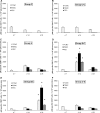Superior protective immunity against murine listeriosis by combined vaccination with CpG DNA and recombinant Salmonella enterica serovar typhimurium
- PMID: 19797070
- PMCID: PMC2786444
- DOI: 10.1128/IAI.00700-09
Superior protective immunity against murine listeriosis by combined vaccination with CpG DNA and recombinant Salmonella enterica serovar typhimurium
Abstract
Preexisting antivector immunity can severely compromise the ability of Salmonella enterica serovar Typhimurium live vaccines to induce protective CD8 T-cell frequencies after type III secretion system-mediated heterologous protein translocation in orally immunized mice. To circumvent this problem, we injected CpG DNA admixed to the immunodominant p60(217-225) peptide from Listeria monocytogenes subcutaneously into BALB/c mice and coadministered a p60-translocating Salmonella strain by the orogastric route. The distribution of tetramer-positive p60(217-225)-specific effector and memory CD8 T cells was analyzed by costaining of lymphocytes with CD62L and CD127. In contrast to the single oral application of recombinant Salmonella or single immunization with CpG and p60, in the spleens from mice immunized with a combination of both vaccine types a significantly higher level of p60-specific CD8 T cells with a predominance of the effector memory T-cell subset was detected. In vivo protection studies revealed that this CD8 T-cell population conferred sterile protective immunity against a lethal infection with L. monocytogenes. However, p60-specific central memory CD8 T cells induced by single vaccination with CpG and p60 were not able confer effective protection against rapidly replicating intracellular Listeria. In conclusion, we provide compelling evidence that the combination of Salmonella type III-mediated antigen delivery and CpG immunization is an attractive novel vaccination strategy to modulate CD8 differentiation patterns toward distinct antigen-specific T-cell subsets with favorable protective capacities.
Figures




Similar articles
-
Pre-existing anti-Salmonella vector immunity prevents the development of protective antigen-specific CD8 T-cell frequencies against murine listeriosis.Microbes Infect. 2007 Oct;9(12-13):1447-53. doi: 10.1016/j.micinf.2007.07.010. Epub 2007 Aug 7. Microbes Infect. 2007. PMID: 17913544
-
Concomitant cytosolic delivery of two immunodominant listerial antigens by Salmonella enterica serovar typhimurium confers superior protection against murine listeriosis.Infect Immun. 2002 Dec;70(12):7114-9. doi: 10.1128/IAI.70.12.7114-7119.2002. Infect Immun. 2002. PMID: 12438393 Free PMC article.
-
Prophylactic anti-tumor immunity against a murine fibrosarcoma triggered by the Salmonella type III secretion system.Microbes Infect. 2006 Aug;8(9-10):2539-46. doi: 10.1016/j.micinf.2006.07.004. Epub 2006 Aug 1. Microbes Infect. 2006. PMID: 16919987
-
Salmonella type III-mediated heterologous antigen delivery: a versatile oral vaccination strategy to induce cellular immunity against infectious agents and tumors.Int J Med Microbiol. 2008 Jan;298(1-2):99-103. doi: 10.1016/j.ijmm.2007.07.002. Epub 2007 Aug 23. Int J Med Microbiol. 2008. PMID: 17719275 Review.
-
Probing CD8 T cell responses with Listeria monocytogenes infection.Adv Immunol. 2012;113:51-80. doi: 10.1016/B978-0-12-394590-7.00005-1. Adv Immunol. 2012. PMID: 22244579 Review.
Cited by
-
Assessment of the phenotype and functionality of porcine CD8 T cell responses following vaccination with live attenuated classical swine fever virus (CSFV) and virulent CSFV challenge.Clin Vaccine Immunol. 2013 Oct;20(10):1604-16. doi: 10.1128/CVI.00415-13. Epub 2013 Aug 21. Clin Vaccine Immunol. 2013. PMID: 23966552 Free PMC article.
-
Tumor antigen delivered by Salmonella III secretion protein fused with heat shock protein 70 induces protection and eradication against murine melanoma.Cancer Sci. 2010 Dec;101(12):2621-8. doi: 10.1111/j.1349-7006.2010.01722.x. Epub 2010 Sep 30. Cancer Sci. 2010. PMID: 20880334 Free PMC article.
-
Immunity, immunopathology, and human vaccine development against sexually transmitted Chlamydia trachomatis.Hum Vaccin Immunother. 2014;10(9):2664-73. doi: 10.4161/hv.29683. Hum Vaccin Immunother. 2014. PMID: 25483666 Free PMC article. Review.
-
Cell-Mediated Immunity Generated in Response to a Purified Inactivated Vaccine for Dengue Virus Type 1.mSphere. 2020 Jan 22;5(1):e00671-19. doi: 10.1128/mSphere.00671-19. mSphere. 2020. PMID: 31969476 Free PMC article. Clinical Trial.
-
CD8 T-cell induction against vascular endothelial growth factor receptor 2 by Salmonella for vaccination purposes against a murine melanoma.PLoS One. 2012;7(4):e34214. doi: 10.1371/journal.pone.0034214. Epub 2012 Apr 12. PLoS One. 2012. PMID: 22511934 Free PMC article.
References
-
- Akira, S., K. Takeda, and T. Kaisho. 2001. Toll-like receptors: critical proteins linking innate and acquired immunity. Nat. Immunol. 2:675-680. - PubMed
-
- Bachmann, M. F., P. Wolint, K. Schwarz, and A. Oxenius. 2005. Recall proliferation potential of memory CD8+ T cells and antiviral protection. J. Immunol. 175:4677-4685. - PubMed
-
- Bachmann, M. F., P. Wolint, K. Schwarz, P. Jager, and A. Oxenius. 2005. Functional properties and lineage relationship of CD8+ T-cell subsets identified by expression of IL-7 receptor alpha and CD62L. J. Immunol. 175:4686-4696. - PubMed
-
- Bishop, D. K., and D. J. Hinrichs. 1987. Adoptive transfer of immunity to Listeria monocytogenes. The influence of in vitro stimulation on lymphocyte subset requirements. J. Immunol. 139:2005-2009. - PubMed
-
- Bourquin, C., D. Anz, K. Zwiorek, A. L. Lanz, S. Fuchs, S. Weigel, C. Wurzenberger, P. von der Borch, M. Golic, S. Moder, G. Winter, C. Coester, and S. Endres. 2008. Targeting CpG oligonucleotides to the lymph node by nanoparticles elicits efficient antitumoral immunity. J. Immunol. 181:2990-2998. - PubMed
Publication types
MeSH terms
Substances
LinkOut - more resources
Full Text Sources
Other Literature Sources
Medical
Research Materials

